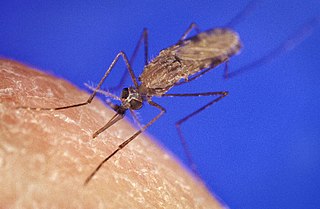
The Culicomorpha are an infraorder of Nematocera, including mosquitoes, black flies, and several extant and extinct families of insects. They originated 176 million years ago, in the Triassic period. There are phylogenetic patterns that are used to interpret bionomic features such as differences in the nature of blood-feeding by adult females, daytime or nighttime feeding by adult females, and occurrence of immature stages in aquatic habitats.

The Chironomidae comprise a family of nematoceran flies with a global distribution. They are closely related to the Ceratopogonidae, Simuliidae, and Thaumaleidae. Many species superficially resemble mosquitoes, but they lack the wing scales and elongated mouthparts of the Culicidae.
Antillocladius is a genus of midges belonging to the family Chironomidae, subfamily Orthocladiinae. The name Antillocladius means orthoclad that occurs in the Antilles, where it was primarily recorded.
Issikiopteryx is a genus of moths in the family Lecithoceridae.
Abiskomyia is a genus of European non-biting midges in the subfamily Orthocladiinae of the bloodworm family (Chironomidae).
Arctodiamesa is a genus of non-biting midges in the subfamily Diamesinae of the bloodworm family Chironomidae.
Smittia is a genus of European non-biting midges in the subfamily Orthocladiinae of the bloodworm family (Chironomidae).

Chironomini is a tribe of midges in the non-biting midge family (Chironomidae).

Polypedilum is a genus of non-biting midges in the subfamily Chironominae of the bloodworm family Chironomidae. This is probably the most species-rich of all chironomid genera. Larvae of Polypedilum may also be among the most abundant invertebrates in eutrophic ponds, reaching densities of up to 1200 larvae per square meter.
Cladopelma is a genus of non-biting midges in the subfamily Chironominae and tribe Chironomini of the bloodworm family Chironomidae. Species are distributed world-wide, with species represented in the Palaearctic, Nearctic, Neotropical, Afrotropical, Sino-Indian, and Austroasian regions.
Pseudokiefferiella is a genus of European non-biting midges in the subfamily Chironominae of the bloodworm family Chironomidae.

Diamesinae is a subfamily of midges in the non-biting midge family (Chironomidae).
Diamesini is a tribe of midges in the non-biting midge family (Chironomidae).
Diamesa is a genus of non-biting midges in the subfamily Diamesinae of the bloodworm family Chironomidae.
Syndiamesa is a genus of non-biting midges in the subfamily Diamesinae of the bloodworm family Chironomidae.
Sympotthastia is a genus of non-biting midges in the subfamily Diamesinae of the bloodworm family Chironomidae.
Pseudodiamesa is a genus of non-biting midges in the subfamily Diamesinae of the bloodworm family Chironomidae.

Potthastia is a genus of non-biting midges in the subfamily Diamesinae of the bloodworm family Chironomidae.
Aagaardia is a genus of fly in the Chironomidae family. Aagaardia has been found in Finland, the mainland of Norway and Russia.
Belgica albipes is a species of non-flying lake fly first described by Eugène Séguy in 1965. Belgica albipes is part of the genus Belgica and the family Chironomidae. The insect lives in the Crozet Islands.



